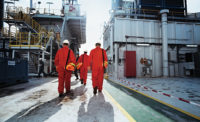1) Sensor issues
Use the appropriate sensors for the job, particularly if your front line crews are doing their own monitoring. The typical confined space configuration is oxygen, flammables, carbon monoxide and hydrogen sulfide. If your personnel encounter other contaminants they will need to use different or additional detection instruments.Most instruments use electrochemical sensors for both oxygen and toxic materials. The oxygen sensor is subject to rapid wear since oxygen is present at all times around the instrument. Oxygen sensors typically last about one to two years. With other electrochemical sensors used to detect toxic materials cross-sensitivity or cross-interference is a major concern.
For flammables the most common sensor is the catalytic bead type. These sensors rely upon a catalytic combustion process on a heated coil to determine the percent of the lower explosive limit (LEL) of the atmosphere being tested. Because it is a combustion process, it is oxygen-dependent. Below the 10-percent oxygen level the readings will be artificially low, possibly indicating an area is safe from a flammable gas or vapor when, in fact, more oxygen will make the atmosphere unsafe. When workers see that the oxygen is low they may attempt to introduce fresh air using ventilation and inadvertently make the atmosphere more dangerous. If you routinely need to measure for percent LEL in oxygen-deficient atmospheres a dilution tube may be used with catalytic bead sensors, or you could switch to an instrument that is capable of using an infrared sensor.
Concentrations of flammables above the LEL also create problems. Most modern instruments have an automatic feature to prevent damage to the sensor in this situation. The display will lock on “Over Range†or some similar indication, and the instrument will shut power off to the sensor to avoid burning up the coil. The instrument also alarms. If this occurs most instruments will have to be turned off, taken to fresh air and restarted.
2) Remote sampling
The most common system for remote sampling is the pump and tube system. Not enough tubing is a common problem. Manufacturers typically permit up to 25, 50 or 100 feet of tubing. Many organizations do not provide sufficient tubing to their crews to reach the bottom of all the spaces that need to be entered. Horizontal reach is another concern as many probes are much too short to effectively sample from deep inside a horizontally entered space. Extensions such as a telescoping painter’s pole must be used in the field.Delay caused by the time it takes the atmosphere being tested to travel through the tubing must also be considered. On average, air moves through the tubing at about one foot per second. For a 60-foot section of tubing the delay would be about one minute.
Other problems associated with remote sampling include:
3) Operating conditions
All instruments have operating condition ranges that the manufacturer considers acceptable. The two primary issues are temperature and humidity. Most modern instruments have relatively wide operating condition ranges, so in the typical confined space entry this will not be a concern. In extreme conditions, though, this can be a significant issue.4) Power
Power issues primarily involve not having enough when you need it. Many rechargeable instruments have operating times of eight to ten hours, usually enough for the average confined space entry. Improvements in battery technology — lithium ion instead of nickel cadmium, for example — have helped matters.Have a plan “B†and even a plan “C†for backup. A secondary power option could be to use readily available regular batteries.

